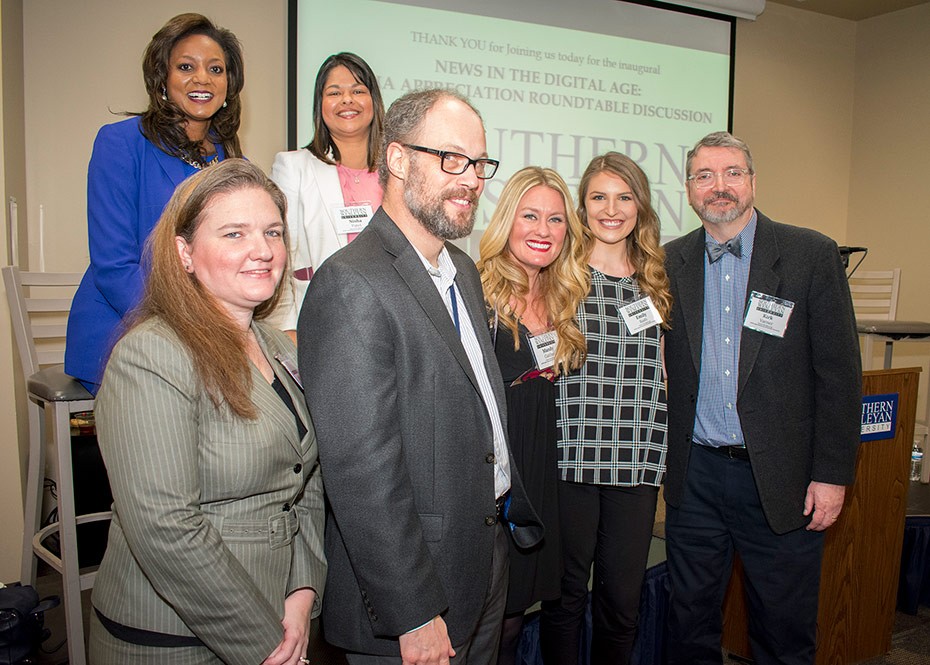
News in the Digital Age—A Media Event at Southern Wesleyan University
Kierra Gilbert
“News in the Digital Age” was a media news panel discussion that was first held here at Southern Wesleyan University on January 26 at the Central campus. The panel was made up of the following people:
- Emily Rash- Public relations for Marleylilly
- Kelly Boan- News director for the Fox Carolina
- Kirk Varner- News director for WSPA-TV
- Mandy Gaither- WYFF-TV
- Steve Bruss- S.C regional news director for Greenville news and Anderson Independent
- Nisha Patel- Client services manager at Crawford Strategy
- Sharon Johnson- Moderator, communications director for Pickens County and former WYFF-TV reporter
The overall panel consists of questions that were asked by students and professors about how news is evolving throughout each generation. Each person gave their profession and what roles they take on in the news and media industry. They explained how the news can sometimes be a tough place to work and the risk that comes along with it. After the panel gave brief information about their occupation they opened the floor to a Q and A session for about thirty minutes. They answered various of questions that were answered to the best of their ability.
One of the most concern questions of news is “How does it work”? Society is and always will be affected by their choice of news and the quality of the news that they watch. When people mention the word “news” or “media” they usually are referring to various sources that are either written or discuss current events. The news includes magazines, television shows, newspapers, internet sources- such as independent blogs and online newspapers. The internet especially has changed the way news sources communicate with their audience and has made it a bit difficult to actually define what “news media” is. There are news organizations that are bigger than others, some towns have their very own local TV station and newspaper that focuses mainly on community events and issues.
“How are new stories written”? When writing a news story, the first thing a journalist or reporter needs is an idea. In order to find their idea, they will either have people approach them with interesting stories or find ideas within their communities. They sometimes will even look online for new ideas. Then the reporter/journalist will either “pitch” or explain their idea to their main editor. They will have to be given the approval from their editor if the story is good for the idea. Then they have to scout out their communities for collectible information. Depending on what idea they are covering, they might: search through public documentation, interview people, or attend events. They must have enough information to cover the topic they are doing the report on to make sure they have equal sides of anything controversial.
Once they have everything they need, they can begin to write their story. Once completed, the final step is handing over the finished story to the editor- who reviews it and makes sure all information is clear and all facts are right. Once given the okay and the story is completed, it can be published; whether it is ready by a TV news anchor, printed in a newspaper, or posted online.
One of the biggest topics discussed at the panel was how news is becoming more and more digital. Newspapers are not as popular as they use to be some time ago, and because networking is becoming more relevant, media is changing courses. They discussed how media is used online and gave good examples of why it is becoming more popular each day. Their reason being that technology is dramatically increasing every year. Every year there is new technology coming out or a must-have update is being installed. Now it is to the point where either you have to keep updating or settle for using out of date equipment. If you are working in the news industry, you have to use equipment that will better suit your audience and make work more efficient. The biggest audience that is more compatible with newer technology is young adults between the ages of 18 to 26.
For anyone that has interest in media and news business, it is difficult to avoid the fact that newspapers are almost at their downfall. Each day a topic about bankruptcies, layoffs, and closings are displayed in print journalism industry. The first casualties were the afternoon newspapers. People that came home from a long day of work will turn on a TV instead of opening a newspaper, more due to TV being more companionable for ad revenue. In a world of high-speed internet and smartphones, newspapers have faced the dropping of price, the loss of advertising, and the tumbling ad sales. In the United States, the industry has shed about a fifth of its journalists since 2001.
The arrival of televisions began the decline of print media as a majority of people’s primary news source. Even though during the time TV sets were more expensive then newspapers, they were a lot more convenient and gave the audience a more visual view of the news. We live in a world where news and media are rapidly changing day by day. It all started with a newspaper that would be on your doorstep at 5 o’clock to be able to have access 24/7 to any newscast of your choice.